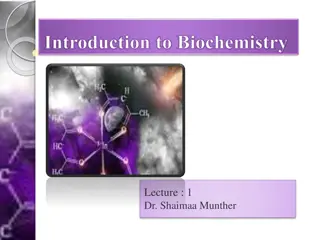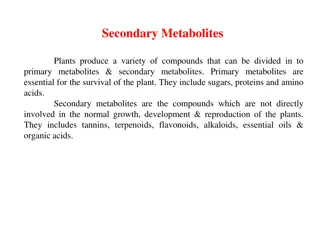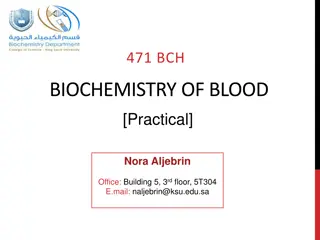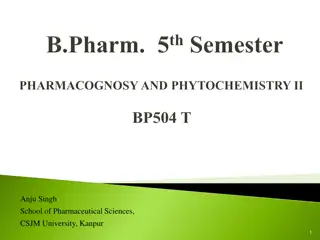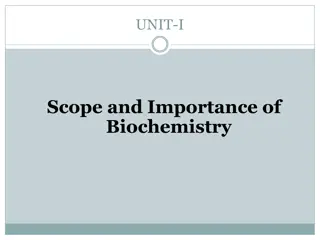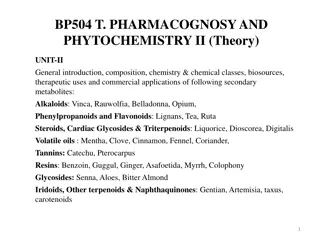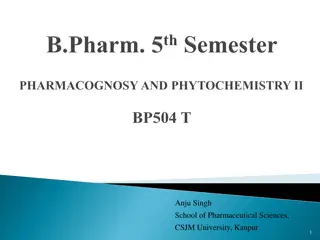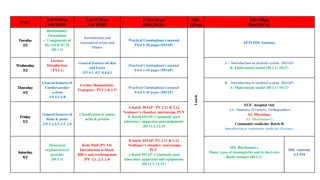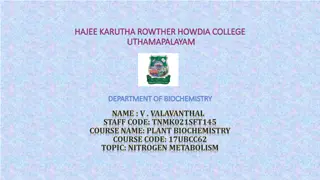Understanding Phenylpropanoids and Flavonoids in Plant Biochemistry
Phenylpropanoids and flavonoids are essential organic compounds synthesized by plants from amino acids like phenylalanine and tyrosine. They play a crucial role in the biosynthesis of various natural products, including lignols, flavonoids, coumarins, and more. The classification of phenylpropanoids is based on chemical moieties like hydroxycinnamic acids, phenylpropenes, and coumarins, each contributing to the diverse functions and properties of plants.
Download Presentation

Please find below an Image/Link to download the presentation.
The content on the website is provided AS IS for your information and personal use only. It may not be sold, licensed, or shared on other websites without obtaining consent from the author. Download presentation by click this link. If you encounter any issues during the download, it is possible that the publisher has removed the file from their server.
E N D
Presentation Transcript
Phenylpropanoids and Flavonoids
PHENYLPROPANOIDS Phenylpropanoids a diverse family of organic compounds synthesized by plants from the aminoacids phenylalanine & tyrosine Name derived from the 6-carbon, aromatic phenyl group and the 3-carbon propene tail of coumaric acid, which is the central intermediate in phenylpropanoid biosynthesis From 4-coumaroyl-CoA - the biosynthesis of countless natural products including lignols (precursors to lignin and lignocellulose), flavonoids, isoflavonoids, coumarins, aurones, stilbenes, catechin, and phenylpropanoids coumaroyl component is produced from cinnamic acid
Phenylpropanoids Pathway & Phyenylpropanoid Acetate Pathway
Phenylpropanoids : Products of the shikkimic acid pathway
CLASSIFICATION OF PHENYLPROPANOIDS The phenylpropanoids- classified on the basis of basic chemical moieties 1. Hydroxycinnamic acids (hydroxycinnamates) are a class of aromatic acids or phenylpropanoids having a C6 C3skeleton. These compounds are hydroxy derivatives of cinnamic acid. -Cyano-4-hydroxycinnamic acid Caffeic acid 3, 4-Dihydroxycinnamic acid. hawthorn, artichoke, pear, basil, thyme, oregano, apple Cichoric acid Cinnamic acid aloe Chlorogenic acid strawberries, pineapple, coffee, sunflower, blueberries Diferulic acids Coumaric acid Ferulic acid (3-methoxy-4-hydroxycinnamic acid) oats, rice, artichoke, orange, pineapple, apple, peanut Sinapinic acid (3,5-dimethoxy-4-hydroxycinnamic acid or sinapic acid) black mustard
CLASSIFICATION OF PHENYLPROPANOIDS (ii) Phenylpropenes phenyl group attached to allyl. Eugenol, chavicol, estragole, and anethole contribute to the flavor and aroma of a number of important herbs and spices. Phenylpropenes, a large group of plant volatile compounds that serve in multiple roles in defense and pollinator attraction, contain a propenyl side chain are precursors for a variety of insecticides. Myristicin Anethole Eugenol
CLASSIFICATION OF PHENYLPROPANOIDS (iii) Coumarins hydroxy-coumarins and furanocoumarins family of benzopyrones (1,2-benzopyrones or 2H-1-benzopyran-2-ones) widely distributed in the nature. Represent important family of naturally occurring and/or synthetic oxygen-containing heterocycles, bearing a typical benzopyrone framework French term for the Tonka bean, coumarou, seeds of Dipteryx odorata (Coumarouna odorata) (Fabaceae/Leguminosae) one of the sources from which coumarin was first isolated as a natural product in 1820.
CLASSIFICATION OF PHENYLPROPANOIDS Coumarins Has sweet odor, easy to be recognized as the scent of new- mown hay; because of that, coumarin has been used in perfumes since 1882 class of lactones structurally constructed by a benzene ring fused to -pyrone ring, Coumarin was first synthesized in 1868, precursor in the synthesis of a number of synthetic anticoagulant pharmaceuticals, starting with dicoumarol simple coumarins, furocoumarins, dihydrofurocoumarins, pyranocoumarins (linear and angular), phenylcoumarins, and biscoumarins
CLASSIFICATION OF PHENYLPROPANOIDS Coumarins cis-o-Coumarinic acid lactone; Cumarin; Coumarinic anhydride; Tonka bean comphor. flavouring agent in pharmaceutical formulations Hydroxycoumarins: more common ones are based upon the following substances, such as: umbelliferone (7-hydroxy coumarin), aesculetin (6, 7-dihydroxy-coumarin) and scopoletin (6-methoxy-7- hydroxy coumarin) Furanocoumarins, a class of more complex coumarins occur in natural plant products. Important members of this class: Psoralen; Methoxsalen; Bergapten; and Imperatorin,
CLASSIFICATION OF PHENYLPROPANOIDS (iv) Abridged phenylpropanoids: These possess no side chain or a side chain with one carbon atom They are acids & phenols, rarely alcohols and aldehydes Distributed due to beta oxidation of C3 side chain of para coumaroyl CoA and para cinnamoyl CoA followed by oxidative decarboxylation Classified into a) With no side chain: catechol b) With side chain having one C atom: gallic acid, benzoic acid, salicin, vanillin, methyl salicylate c) With side chain having 2 C atom: phenyl ethanol in essential oils
CLASSIFICATION OF PHENYLPROPANOIDS (v) Biphenylpropenoid derivatives The side chains from 2 phenylpropanoids interact with each other to yield Biphenylpropenoid derivatives commonly termed a) lignans or neolignans : low mol. Wt. , by the oxidative coupling of para-hydroxyphenylpropene units wherein the two units may be linked by an oxygen bridge, Haworth Lignan compounds that are derived by coupling acid and/or alcohol exclusively; whereas, the compounds which are derived by coupling propenyl and/or allyl derivatives are known as Neolignans They occur widely and have been obtained from roots, heart wood, foliage, fruit and resinous exudates of plants. They represent the dimer stage intermediate between the monomeric propylphenol units and lignin examples of lignan are that of etoposide and teriposide b) Flavonoids
CLASSIFICATION OF PHENYLPROPANOIDS (vi) High molecular weight phenylpropanoids Play vital role as buildings units in the formation of high molecular weight polymers in plants. Polymers are broadly classified into Lignins : natural aromatic organic polymers in vascular plants. lignins together with cellulose, and hemicellulose, are the major cell wall components of the fibers of all wood and grass species in the plant kingdom phenolic hydroxy moieties present in the lignins may be either hydrogen bonded or covalently attached to hemicellulose Lignin is usually composed of coniferyl, p-coumaryl and sinapyl alcohols in varying used as a source of vanillin, syringic aldehyde and dimethyl sulphoxide, extender for phenolic plastics, strengthen rubber for shoe-soles, to precipitate proteins
CLASSIFICATION OF PHENYLPROPANOIDS (vi) High molecular weight phenylpropanoids Tannins: Tannic Acid; Gallotannin; Gallotannic acid; Acidum tannicum. as a pharmaceutical aid due to its astringent and antiseptic actions., mordant in dyeing, for tanning i.e., making leather from hides of cow, goat, sheep and buffalo skin., for sizing paper and silk. production of gallic acid and pyrogallol., as a reagent in analyticalchemistry . as a coagulant in the manufacture of rubber., employed to clarify beer and wine.


